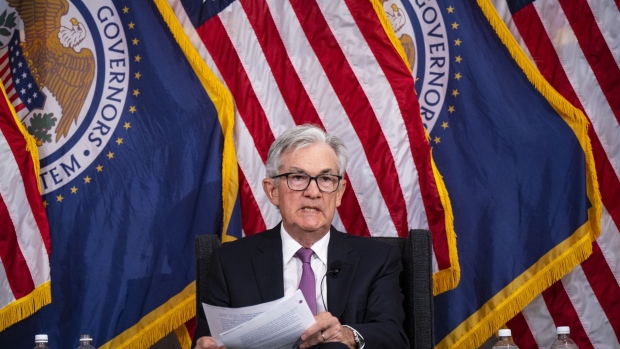May 19, 2023
What Powell Has to Say on Credit Stress, Inflation and Interest Rates
, Bloomberg News

(Bloomberg) -- Federal Reserve Chair Jerome Powell signaled that he’s leaning toward pausing interest-rate increases next month to assess the past year-plus of hikes amid stress in the banking system.
Powell also said that slack in the labor market will be increasingly important in determining the path of inflation. He spoke at a Fed conference on Friday in Washington alongside former chair Ben Bernanke, moderated by Fed economist Trevor Reeve.
Read more: Powell Steers Policy Debate With Clear Signal on June Rate Pause
Here’s a partial transcript of highlights, with Powell reading largely from prepared notes:
Banking Stress
Q: How do you think about the use of financial stability tools and liquidity tools opposed to more traditional monetary policy tools? And how do they fit together?
Powell: “I want to start by saying that the overall banks and the banking system are strong and resilient, and well-positioned to deal with the challenges they may face now or in the future.”
“While the financial stability tools helped to calm conditions in the banking sector, developments there on the other hand are contributing to tighter credit conditions and are likely to weigh on economic growth, hiring and inflation. So as a result, our policy rate may not need to rise as much as it would have otherwise to achieve our goals. Of course the extent of that is highly uncertain.”
Labor Market
Q: Should we be thinking about the relationship between slack in the labor market and inflation differently?
Powell: “I don’t think labor market slack was a particularly important feature of inflation when it first spiked in spring of 2021. By contrast, I do think that labor market slack is likely to be an increasingly important factor in inflation going forward.
“In particular, inflation in non-housing services is showing signs of real persistent. In this highly diverse sector, labor costs are a high proportion of total costs and that sector happens to account for more than half of the core PCE index.”
Policy Communication
Powell: “Of course there are always communication challenges, especially, I find, about communicating the uncertainty that attends our assessments of economic conditions and the outlook. And the good example of this is despite our persistent efforts to explain otherwise, the policy paths from the SEP (Summary of Economic Projections) seem regularly to be taken as a firm plan or a committee decision, rather than what they are, which is a compilation of individual participants’ best assessments, on a particular day, of appropriate policy under the assumption that conditions evolve in line with their baseline forecasts.”
“Despite that, I would say though that the Summary of Economic Projections has actually been very useful during this tightening cycle as markets have looked ahead and priced in future rate hikes long before they are actually implemented.”
Forward Guidance
Powell: “In the current context, until recently, it’s been relatively clear that further policy firming would be warranted and our forward guidance has said so. Now, however, we’ve come a long way in policy tightening and the stance of policy is restrictive and we face uncertainty about the lagged effects of our tightening so far and about the extent of credit tightening from recent banking stresses.
“So today, our guidance is limited to identifying the factors we’ll be monitoring as we assess the extent to which additional policy firming may be appropriate to return inflation to 2% over time. As I noted at the last press conference, that assessment will be an ongoing one as we move ahead meeting by meeting. Having come this far, we can afford to look at the data and the evolving outlook and make careful assessments.
Rate Path
Q: You mentioned guidance can be useful at times when the public may expect a very different policy path than policymakers. How do you think about those sorts of situations?
Powell: “So recently, it has sometimes been the case that markets appear to be pricing in a different rate path than the committee expects will be appropriate. But I would say that that disconnect does not seem to reflect a misunderstanding of our reaction function or a lack of belief that we’ll do what’s necessary to bring inflation down.
“Rather, it appears to reflect simply a different forecast — one in which inflation comes down much more quickly than the committee participants think is most likely. Perhaps due to a significant downturn. I would say also, so far the data have continued to support the committee’s view that bringing inflation down will take some time.”
“Until very recently it’s been clear that further policy firming would be required. As policy has become more restrictive, the risks of doing too much versus doing too little are becoming more balanced and our policy has adjusted to reflect that fact. So we haven’t made any decisions about the extent to which additional policy firming will be appropriate. But given how far we’ve come, as I noted, we can afford to look at the data and the evolving outlook and make careful assessments.”
©2023 Bloomberg L.P.






